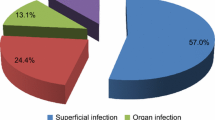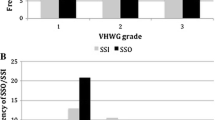Abstract
Introduction
Incisional hernia repair (IHR) carries a high risk of wound complications. Thirty-day outcomes are frequently used in comparative-effectiveness research, but may miss a substantial number of surgical site occurrences (SSO) including surgical site infection (SSI). The objective of this study was to determine an optimal length of follow-up to detect SSI after IHR.
Methods
All adult patients undergoing open IHR at a single academic center over a 3 year period were reviewed. SSIs, non-infectious SSOs, and wound-related readmissions were recorded up to 180 days. The primary outcome was the proportion of SSIs detected at end-points of 30, 60, and 90 days of follow-up. Time-to-event analysis was performed for all outcomes at 30, 60, 90, and 180 days. Logistic regression was used estimate the relative risk of SSI for relevant risk factors.
Results
A total of 234 patients underwent open IHR. Median follow-up time of 102 days. Overall incidence of SSI was 15.8% with median time to occurrence of 23 days. Incidence of non-infectious SSO was 33.2%, and SSO-related readmission was 12.8%. At 30, 60, and 90 days sensitivity was 81.6%, 89.5%, and 92.1 for SSI, and 46.7%, 76.7%, and 83.3% for readmission. In regression analysis, body mass index (RR 1.08, 95% CI 1.00, 1.15, p = 0.04) anterior component separation (RR 4.21, 95% CI 2.09, 6.34, p = 0.003), and emergency surgery (RR 3.25, 95% CI 1.47, 5.02, p = 0.01), were independently associated with SSI after adjusting for age, sex, contamination class, and procedure duration.
Conclusion
A considerable proportion of SSIs occurred beyond 30 days, but 90-day follow-up detected 92% of SSIs. Follow-up to 90 days captured only 83% of SSO-related readmissions. These results have implications for the design of trials evaluating wound complication after open IHR, as early endpoints may miss clinically relevant outcomes and underestimate the number needed to treat. Where possible, we recommend a minimum follow-up of 90 days to estimate wound complications following open IHR.


Similar content being viewed by others
References
Helgstrand F, Rosenberg J, Kehlet H, Jorgensen LN, Bisgaard T (2013) Nationwide prospective study of outcomes after elective incisional hernia repair. J Am Coll Surg 216:217–228
Kaoutzanis C, Leichtle SW, Mouawad NJ, Welch KB, Lampman RM, Wahl WL, Cleary RK (2015) Risk factors for postoperative wound infections and prolonged hospitalization after ventral/incisional hernia repair. Hernia 19:113–123
van Ramshorst GH, Eker HH, Hop WCJ, Jeekel J, Lange JF (2012) Impact of incisional hernia on health-related quality of life and body image: a prospective cohort study. Am J Surg 204:144–150
Plymale MA, Davenport DL, Walsh-Blackmore S, Hess J, Griffiths WS, Plymale MC, Totten CF, Roth JS (2020) Costs and complications associated with infected mesh for ventral hernia repair. Surg Infect 21:344–349
Cox TC, Blair LJ, Huntington CR, Colavita PD, Prasad T, Lincourt AE, Heniford BT, Augenstein VA (2016) The cost of preventable comorbidities on wound complications in open ventral hernia repair. J Surg Res 206:214–222
Lauren Paton B, Novitsky YW, Zerey M, Sing RF, Kercher KW, Todd Heniford B (2007) Management of infections of polytetrafluoroethylene-based mesh. Surg Infect 8:337–342
Miller JN, Colditz GA, Mosteller F (1989) How study design affects outcomes in comparisons of therapy. II: surgical. Stat Med 8:455–466
Poruk KE, Hicks CW, Trent Magruder J, Rodriguez-Unda N, Burce KK, Azoury SC, Cornell P, Cooney CM, Eckhauser FE (2017) Creation of a novel risk score for surgical site infection and occurrence after ventral hernia repair. Hernia 21:261–269
Burkhart RA, Javed AA, Ronnekleiv-Kelly S, Wright MJ, Poruk KE, Eckhauser F, Makary MA, Cameron JL, Wolfgang CL, He J, Weiss MJ (2017) The use of negative pressure wound therapy to prevent post-operative surgical site infections following pancreaticoduodenectomy. HPB 19:825–831
Pauli EM, Krpata DM, Novitsky YW, Rosen MJ (2013) Negative pressure therapy for high-risk abdominal wall reconstruction incisions. Surg Infect 14:270–274
Holihan JL, Flores-Gonzalez JR, Mo J, Ko TC, Kao LS, Liang MK (2017) How long is long enough to identify a surgical site infection? Surg Infect 18:419–423
Lankiewicz JD, Yokoe DS, Olsen MA, Onufrak F, Fraser VJ, Stevenson K, Khan Y, Hooper D, Platt R, Huang SS (2012) Beyond 30 days: does limiting the duration of surgical site infection follow-up limit detection? Infect Control Hosp Epidemiol 33:202–204
Kroese LF, Kleinrensink G-J, Lange JF, Gillion J-F, Ain J-F, Beck M, Barrat C, Berney C, Berrod J-L, Binot D, Boudet M-J, Bousquet J, Blazquez D, Bonan A, Cas O, Champault-Fezais A, Chastan P, Cardin J-L, Chollet J-M, Cossa J-P, Dabrowski A, Démaret S, Drissi F, Durou J, Dugue T, Faure J-P, Framery D, Fromont G, Gainant A, Gauduchon L, Genser L, Gillion J-F, Guillaud A, Jacquin C, Jurczak F, Khalil H, Lacroix A, Ledaguenel P, Lepère M, Lépront D, Letoux N, Loriau J, Magne E, Ngo P, Oberlin O, Paterne D, Pavisd’Escurac X, Potiron L, Renard Y, Soler M, Rignier P, Roos S, Thillois J-M, Tiry P, Verhaeghe R, Vu P, Zaranis C (2018) External validation of the European hernia society classification for postoperative complications after incisional hernia repair: a cohort study of 2,191 patients. J Am Coll Surg 226:223–229
Kokotovic D, Bisgaard T, Helgstrand F (2016) Long-term recurrence and complications associated with elective incisional hernia repair. JAMA 316:1575–1582
Holihan JL, Alawadi Z, Martindale RG, Roth JS, Wray CJ, Ko TC, Kao LS, Liang MK (2015) Adverse events after ventral hernia repair: the vicious cycle of complications. J Am Coll Surg 221:478–485
Fischer JP, Wink JD, Nelson JA, Kovach SJ 3rd (2014) Among 1,706 cases of abdominal wall reconstruction, what factors influence the occurrence of major operative complications? Surgery 155:311–319
Kanters AE, Krpata DM, Blatnik JA, Novitsky YM, Rosen MJ (2012) Modified hernia grading scale to stratify surgical site occurrence after open ventral hernia repairs. J Am Coll Surg 215:787–793
Berger RL, Li LT, Hicks SC, Davila JA, Kao LS, Liang MK (2013) Development and validation of a risk-stratification score for surgical site occurrence and surgical site infection after open ventral hernia repair. J Am Coll Surg 217:974–982
Parker SG, Halligan S, Liang MK, Muysoms FE, Adrales GL, Boutall A, de Beaux AC, Dietz UA, Divino CM, Hawn MT, Heniford TB, Hong JP, Ibrahim N, Itani KMF, Jorgensen LN, Montgomery A, Morales-Conde S, Renard Y, Sanders DL, Smart NJ, Torkington JJ, Windsor ACJ (2020) International classification of abdominal wall planes (ICAP) to describe mesh insertion for ventral hernia repair. Br J Surg 107:209–217
Centers for Disease Control (2019) National Healthcare Safety Network Surveillance (NHSN) patient safety component manual 2019. Centers for Disease Control, Atlanda
Slater NJ, Montgomery A, Berrevoet F, Carbonell AM, Chang A, Franklin M, Kercher KW, Lammers BJ, Parra-Davilla E, Roll S, Towfigh S, van Geffen E, Conze J, van Goor H (2014) Criteria for definition of a complex abdominal wall hernia. Hernia 18:7–17
Ventral Hernia Working Group, Breuing K, Butler CE, Ferzoco S, Franz M, Hultman CS, Kilbridge JF, Rosen M, Silverman RP, Vargo D (2010) Incisional ventral hernias: review of the literature and recommendations regarding the grading and technique of repair. Surgery 148:544–558
Berríos-Torres SI, Umscheid CA, Bratzler DW, Leas B, Stone EC, Kelz RR, Reinke CE, Morgan S, Solomkin JS, Mazuski JE, Dellinger EP, Itani KMF, Berbari EF, Segreti J, Parvizi J, Blanchard J, Allen G, Kluytmans JAJW, Donlan R, Schecter WP, Committee HICPA (2017) Centers for disease control and prevention guideline for the prevention of surgical site infection, 2017. JAMA Surg 152:784–791
Haskins IN, Horne CM, Krpata DM, Prabhu AS, Tastaldi L, Perez AJ, Rosenblatt S, Poulose BK, Rosen MJ (2018) A call for standardization of wound events reporting following ventral hernia repair. Hernia 22:729–736
Muysoms FE, Deerenberg EB, Peeters E, Agresta F, Berrevoet F, Campanelli G, Ceelen W, Champault GG, Corcione F, Cuccurullo D, DeBeaux AC, Dietz UA, Fitzgibbons RJ Jr, Gillion JF, Hilgers R-D, Jeekel J, Kyle-Leinhase I, Köckerling F, Mandala V, Montgomery A, Morales-Conde S, Simmermacher RKJ, Schumpelick V, Smietański M, Walgenbach M, Miserez M (2013) Recommendations for reporting outcome results in abdominal wall repair: results of a consensus meeting in Palermo, Italy, 28–30 June 2012. Hernia 17:423–433
Baucom RB, Ousley J, Oyefule OO, Stewart MK, Phillips SE, Browman KK, Sharp KW, Holzman MD, Poulose BK (2016) Evaluation of long-term surgical site occurrences in ventral hernia repair: implications of preoperative site independent MRSA infection. Hernia 20:701–710
Centers for Disease Control and Prevention (2022) Procedure-associated Module: Surgical Site Infection. National Healthcare Safety Network. https://www.cdc.gov/nhsn/pdfs/pscmanual/9pscssicurrent.pdf
American College of Surgeons National Surgical Quality Improvement Program (ACS NSQIP) (2018) User Guide for the 2017 ACS NSQIP Participant Use Data File (PUF). ACS NSQIP. https://www.facs.org/qualityprograms/acs-nsqip/participant-use
Sun BJ, Kamal RN, Lee GK, Nazerali RS (2018) Quality measures in ventral hernia repair: a systematic review. Hernia 22:1023–1032
Bernardi K, Liang MK (2019) Establishing a hernia program. In: Davis SS, Dakin G, Bates A (eds) The SAGES manual of hernia surgery. Springer, Cham, pp 595–610
Muysoms F, Campanelli G, Champault GG, DeBeaux AC, Dietz UA, Jeekel J, Klinge U, Köckerling F, Mandala V, Montgomery A, Morales Conde S, Puppe F, Simmermacher RKJ, Śmietański M, Miserez M (2012) EuraHS: the development of an international online platform for registration and outcome measurement of ventral abdominal wall hernia repair. Hernia 16:239–250
Hicks CW, Poruk KE, Baltodano PA, Soares KC, Azoury SC, Cooney CM, Cornell P, Eckhauser FE (2016) Long-term outcomes of sandwich ventral hernia repair paired with hybrid vacuum-assisted closure. J Surg Res 204:282–287
Soares KC, Baltodano PA, Hicks CW, Cooney CM, Olorundare IO, Cornell P, Burce K, Eckhauser FE (2015) Novel wound management system reduction of surgical site morbidity after ventral hernia repairs: a critical analysis. Am J Surg 209:324–332
Tran BNN, Johnson AR, Shen C, Lee BT, Lee ES (2019) Closed-incision negative-pressure therapy efficacy in abdominal wall reconstruction in high-risk patients: a meta-analysis. J Surg Res 241:63–71
Hopkins B, Eustache J, Ganescu O, Cipolla J, Kaneva P, Fried GM, Khwaja K, Vassiliou M, Fata P, Lee L, Feldman LS (2020) S116: Impact of incisional negative pressure wound therapy on surgical site infection after complex incisional hernia repair: a retrospective matched cohort study. Surg Endosc. https://doi.org/10.1007/s00464-020-07857-1
Bueno-Lledó J, Franco-Bernal A, Garcia-Voz-Mediano MT, Torregrosa-Gallud A, Bonafé S (2020) Prophylactic single-use negative pressure dressing in closed surgical wounds after incisional hernia repair: a randomized, controlled trial. Ann Surg. https://doi.org/10.1097/SLA.0000000000005271
Kajmolli A, Mcguirk M (2020) Assess the efficacy of prevena plus vs SOC to closed incision in Pts undergoing CAWR and other laparotomy procedures. Identifier NCT: 04539015. https://clinicaltrials.gov/ct2/show/NCT04539015. Accessed 10 Nov 2020
How NE, Blewett CE (2020) Negative pressure incisional wound therapy for high-risk ventral hernia repair. Identifier NCT04455724. https://clinicaltrials.gov/ct2/show/NCT04455724. Accessed 10 Nov 2020
Author information
Authors and Affiliations
Corresponding author
Ethics declarations
Disclosures
Dr. Feldman has received educational Grants from Merck. Dr. Lee has received an investigator-initiated research Grant from Johnson & Johnson. Drs. Hopkins, Eustaches, Fiore, Ganescu, and Cipolla have no conflict of interest or financial ties to disclose. Ms. Kaneva have no conflict of interest or financial ties to disclose.
Additional information
Publisher's Note
Springer Nature remains neutral with regard to jurisdictional claims in published maps and institutional affiliations.
Rights and permissions
About this article
Cite this article
Hopkins, B., Eustache, J., Ganescu, O. et al. At least ninety days of follow-up are required to adequately detect wound outcomes after open incisional hernia repair. Surg Endosc 36, 8463–8471 (2022). https://doi.org/10.1007/s00464-022-09143-8
Received:
Accepted:
Published:
Issue Date:
DOI: https://doi.org/10.1007/s00464-022-09143-8




